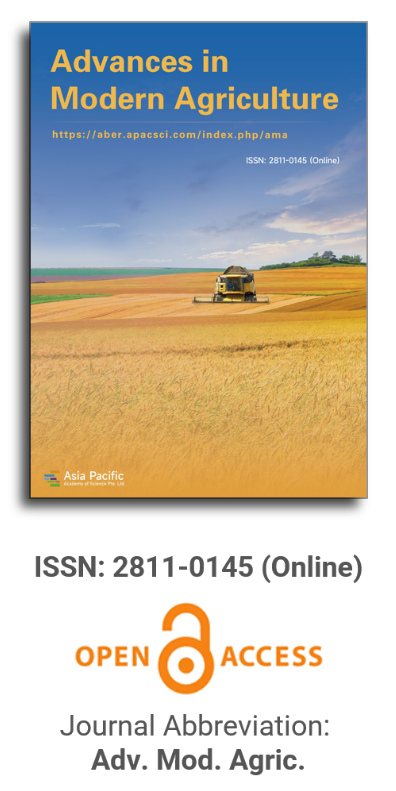


Screening of Vigna subterranean L. Verdc. accessions for waterlogging stress tolerance
Vol 4, Issue 2, 2023
VIEWS - 3097 (Abstract)
Download PDF
Abstract
This study evaluated the influence of waterlogging stress on the growth of six (6) accessions (TvSu-1, TvSu-2, TvSu-3, TvSu-4, TvSu-5, and TvSu-10) of Vigna subterranean in a pot experiment. The experiment was setup in a complete block design (CBD) with 3 replicates per treatment. Results of growth parameters of V. subterranean accessions under waterlogging stress, such as plant height, leaf area, petiole length, and number of nodes, were significantly (p = 0.05) decreased when compared to their controls after 8 weeks of planting. For shoot length, TvSu-2 (1.60 ± 0.20 cm) and TvSu-4 (1.60 ± 0.20 cm) recorded the highest values, while TvSu-5 (1.23 ± 0.03) and TvSu-10 (1.23 ± 0.03) had the lowest values, respectively. TvSu-5 (19.03 ± 0.59 cm2) and TvSu-10 (19.03 ± 0.59 cm2) recorded the highest values in leaf area (LA), while TvSu-3 (14.40 ± 0.51 cm2) had the lowest LA. For total photosynthetic pigment (TPP), TvSu-2, TvSu-4, and TvSu-10 had the highest values, with 57.35 ± 1.82 mg/kg, 55.80 ± 2.70 mg/kg, and 55.77 ± 1.90 mg/kg, respectively. TvSu-3 (41.50 ± 8.29 mg/kg) maintained the lowest value. In petiole length, TvSu-5 (15.23 ± 0.33 cm) and TvSu-4 (14.20 ± 0.66cm) had the highest values, while TvSu-3 (8.97 ± 0.33 cm) had the lowest. For the number of nodes, TvSu-2 (15.00 ± 1.76) and TvSu-4 (12.00 ± 1.73) recorded the highest values, while TvSu-10 (10.00 ± 1.00) had the lowest value. Biomass yield analysis of the stressed V. subterranean showed that total fresh weight (TFW), root length (RL), root fresh weight (RFW), shoot fresh weight (SFW), leaf fresh weight (LFW), leaf turgid weight (LTW), total dry weight (TDW), root dry weight (RDW), shoot dry weight (SDW), and leaf dry weight (LDW) of the six accessions were significantly (p = 0.05) decreased when compared to their control. Tvsu-5 had a better biomass yield when compared to other accessions, recording the highest values in SDW (1.62 g), RDW (0.55 g), LFW (0.75 g), SFW (10.31 g), and RL (18.53 ± 0.66). Conclusively, waterlogging stress negatively impacted V. subterranean accessions, but Tvsu-5 had a better waterlogging stress tolerance than other accessions, especially TvSu-3, which was generally poor.
Keywords
References
- Howell JA, Eshbaugh WH, Guttman S, Rabakonandrianina E. Common names given to Bambara groundnut (Vigna subterranea) in Madagascar. Economic Botany 1994; 48: 217–221.
- Borget M. Food Legumes. Macmillan Publishers; 1992.
- Ogwu MC, Ahana CM, Osawaru ME. Sustainable food production in Nigeria: A case study for Bambara groundnut (Vigna subterranea (L.) Verdc. Fabaceae). Journal of Energy and Natural Resource Management 2018; 1(1): 68–78. doi: 10.26796/jenrm.v1i1.125
- Li X, Siddique KHM. Future smart food: Harnessing the potential of neglected and underutilized species for zero hunger. Maternal & Child Nutrition 2020; 16(S3): e13008. doi: 10.1111/mcn.13008
- Yusuf A, Kopdorah S, Muhammad Y, et al. Effect of domestic processing (cooking and roasting) on antioxidant potential of bambara groundnut extract (Vigna subterranea l. Verdc.). SAU Science-Tech Journal 2021; 6(1): 51–58.
- Adeleke OR, Adiamo OQ, Fawale OS. Nutritional, physicochemical, and functional properties of protein concentrate and isolate of newly‐developed Bambara groundnut (Vigna subterrenea L.) cultivars. Food Science & Nutrition 2017; 6(1): 229–242. doi: 10.1002/fsn3.552
- Linnemann AR, Azam-ali SN. Bambara groundnut (Vigna subterranea). In: Williams JT (editor). Pulses and Vegetables. Chapman and Hall; 1993. pp: 13–58.
- Mabhaudhi T, Modi AT, Beletse YG. Growth responses of a Bambara groundnut landrace to water stress. In: Proceedings of the African Crop Science Conference; 10–13 October 2011; Maputo, Mozambique. Volume 10. pp. 97–102.
- Hamid A, Agata W, Maniruzzaman AFM, Miah AA. Physiological aspects of yield improvement in mungbean. Advances in Pulses Research in Bangladesh, Proceedings of the Second National Workshop on Pulses; 6–8 June 1989; Joydebpur, Bangladesh. Bangladesh Agricultural Research Institute; 1991. pp. 95–101.
- Miah AA, Moniruzzaman AFM, Rahman MM. Problems and prospects of pulses production. In: Kumar J, Sahni BB, Raman U (editors). Advances in Pulses Research in Bangladesh, Proceedings of the Second National Workshop on Pulses; 6–8 June 1989; Joydebpur, Bangladesh. Bangladesh Agricultural Research Institute; 1991. pp. 87–94.
- Rosario DA, Faustino FC. Screening for drought resistance in mungbean. In: Proceedings of the Workshop on Varietal Improvement of Rice Based Farming Systems. 11–15 March 1985; Phitsanulok, Thailand. pp. 188–206.
- Mabhaudhi T, Modi AT. Growth, phenological and yield responses of a Bambara groundnut (Vigna subterranean (L.) Verdc.) landrace to imposed water stress under field conditions. South African Journal of Plant and Soil 2013; 30(2): 69–79. doi: 10.1080/02571862.2013.790492
- Cannell RQ, Gales K, Snaydon RW, et al. Effects of short‐term waterlogging on the growth and yield of peas (Pisum sativum). Annals of Applied Biology 1979; 93(3): 327–335. doi: 10.1111/j.1744-7348.1979.tb06549.x
- Jackson MB. Rapid injury to peas by soil waterlogging. Journal of the Science of Food and Agriculture 1979; 30(2): 143–152. doi: 10.1002/jsfa.2740300208
- Leul M, Zhou WJ. Alleviation of waterlogging damage in winter rape by uniconazole application: Effects on enzyme activity, lipid peroxidation, and membrane integrity. Journal of Plant Growth Regulation 1999; 18(1): 9–14. doi: 10.1007/pl00007046
- Kozlowski TT. Plant responses to flooding of soil. BioScience 1984; 34(3): 162–167. doi: 10.2307/1309751
- Crawford RMM, Braendle R. Oxygen deprivation stress in a changing environment. Journal of Experimental Botany 1996; 47(2): 145–159. doi: 10.1093/jxb/47.2.145
- Vartapetian BB, Jackson MB. Plant adaptations to anaerobic stress. Annals of Botany 1997; 79(suppl 1): 3–20. doi: 10.1093/oxfordjournals.aob.a010303
- Jackson MB, Colmer TD. Response and adaptation by plants to flooding stress. Annals of Botany 2005; 96(4): 501–505. doi: 10.1093/aob/mci205
- Greenway H, Gibbs J, Setter T. Mechanisms of Tolerance to Waterlogging and Submergence. UWA and IRRI; 1994.
- Chai HH, Massawe F, Mayes S. Effects of mild drought stress on the morpho-physiological characteristics of a Bambara groundnut segregating population. Euphytica 2015; 208(2): 225–236. doi: 10.1007/s10681-015-1581-2
- Ambede JG, Netondo GW, Mwai GN, et al. NaCl salinity affects germination, growth, physiology, and biochemistry of bambara groundnut. Brazilian Journal of Plant Physiology 2012; 24(3): 151–160. doi: 10.1590/s1677-04202012000300002
- Sinefu F, Modi AT, Mabhaudhi T. Seed quality components of a Bambara groundnut landrace from Kwazulu-Natal, South Africa. In: Proceedings of the 10th African Crop Science Conference; 10–13 October 2011; Maputo, Mozambique. pp. 149–156.
- van Veen H, Akman M, Jamar DC, et al. Group VII ethylene response factor diversification and regulation in four species from flood-prone environments. Plant, Cell & Environment 2014; 37(10): 2421–2432. doi: 10.1111/pce.12302
- Cannell RQ, Belford RK, Gales K, et al. Effects of waterlogging at different stages of development on the growth and yield of winter wheat. Journal of the Science of Food and Agriculture 1980; 31(2): 117–132. doi: 10.1002/jsfa.2740310203
- Visser EJ, Voesenek LA. Acclimation to soil flooding—sensing and signal-transduction. Plant and Soil 2005; 274: 197–214. doi: 10.1007/s11104-004-1650-0
Supporting Agencies
Copyright (c) 2023 Okon Godwin Okon, Augustine Effiong Archibong, Ofonime Raphael Akata, Imikan Anyieokpon Nyong, Ekomobong Etinam Akpan
License URL: https://creativecommons.org/licenses/by/4.0/

This site is licensed under a Creative Commons Attribution 4.0 International License (CC BY 4.0).

Prof. Zhengjun Qiu
Zhejiang University, China

Cheng Sun
Academician of World Academy of Productivity Science; Executive Chairman, World Confederation of Productivity Science China Chapter, China
Indexing & Archiving
In the realm of modern agriculture, the integration of cutting-edge technologies is revolutionizing the way we approach sustainable farming practices. A recent study published in Advances in Modern Agriculture titled "Classification of cotton water stress using convolutional neural networks and UAV-based RGB imagery" has garnered significant attention for its innovative approach to precision irrigation management. Conducted by researchers from Institute of Data Science and the AgriLife Research and Extension Center of Texas A&M University (authors's information is below). This study introduces a novel method for classifying cotton water stress using unmanned aerial vehicles (UAVs) and convolutional neural networks (CNNs), offering a powerful solution for optimizing water use in agriculture.
Modern agricultural technology is evolving rapidly, with scientists collaborating with leading agricultural enterprises to develop intelligent management practices. These practices utilize advanced systems that provide tailored fertilization and treatment options for large-scale land management.
This journal values human initiative and intelligence, and the employment of AI technologies to write papers that replace the human mind is expressly prohibited. When there is a suspicious submission that uses AI tools to quickly piece together and generate research results, the editorial board of the journal will reject the article, and all journals under the publisher's umbrella will prohibit all authors from submitting their articles.
Readers and authors are asked to exercise caution and strictly adhere to the journal's policy regarding the usage of Artificial Intelligence Generated Content (AIGC) tools.
Asia Pacific Academy of Science Pte. Ltd. (APACSCI) specializes in international journal publishing. APACSCI adopts the open access publishing model and provides an important communication bridge for academic groups whose interest fields include engineering, technology, medicine, computer, mathematics, agriculture and forestry, and environment.



.jpg)
.jpg)

.jpg)
